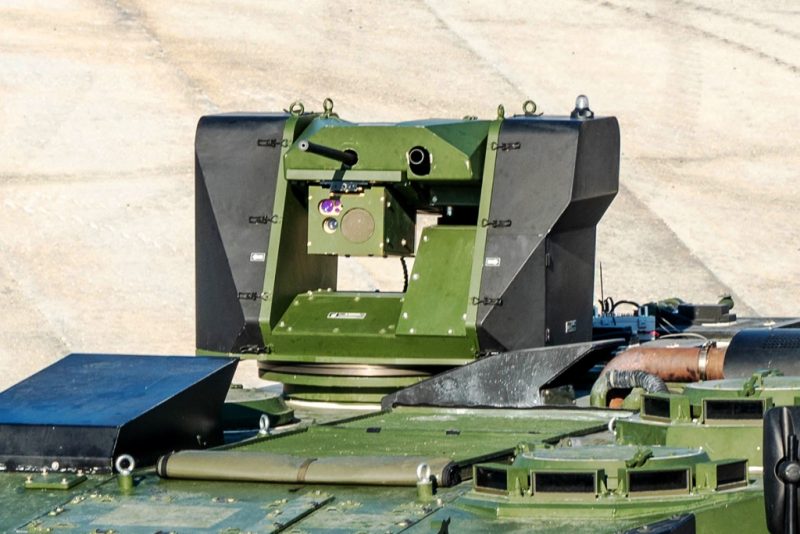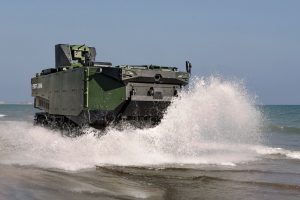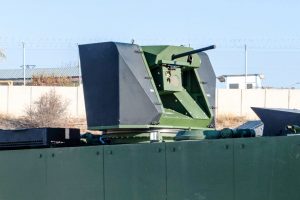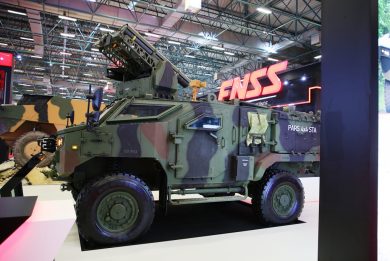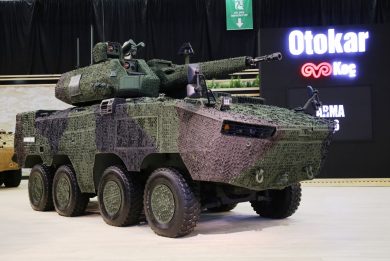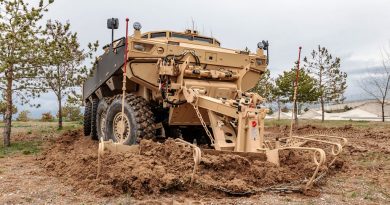FNSS: Caka, a marinised RCWS for the ZAHA AAAV
By Paolo Valpolini
Kept under wrap until the 2021 edition of IDEF, the Caka RCWS was purposely developed to be installed on the ZAHA (Zırhlı Amfibi Hucum Aracı), the new Armoured Amphibious Vehicle designed by FNSS based on Turkish Navy Marines requirements. Designed to host the same weapons to be installed on the Sancak, a 12.7 mm machine gun or a 40 mm automatic grenade launcher (AGL), its architecture is pretty different as the optronic package is here installed under the weapon, and is therefore linked to it, the elevation arc being –7°/+45°. “This solution was the best choice in order to make it waterproof and to protect the system against corrosion,” Gökhan Özyurt,the company Weapon Systems Design Manager tells EDR On-Line, underlining that the design was optimised to answer a series of requirements which differ from those of a purely land turret. The configuration might have allowed to put two weapons side by side, however FNSS engineers decided to adopt a single weapon configuration, allowing it to be in the middle of the cradle, increasing rigidity, which, according to Gökhan Özyurt, is one of the key, factors in improving accuracy providing a consistent impact pattern. Height and weight were also key design issues, the Caka being fitted on top of the ZAHA, which as all AAAVs must be capable to autonomously return into the upright position, should it capsize during navigation; “the overall centre of gravity issue is of key importance, therefore we tried to reduce the weight as much as possible, we are under 700 kg in combat order, with weapon, ammunition and armour, while height is kept at 960 mm,” the designer tells us, adding that many elements are common to the other FNSS RCWS, the Sancak. The Caka is 1,400 mm wide, has a 784 mm ring mount, and a swing radius of 1,960 mm.
As an example, the Caka features the same optronic installed on the Sancak, although these are packed in a different way and hosted in a fully waterproof enclosure, the AAAV typically diving underwater when splashing from the stern ramp of an amphibious ship before coming back afloat and start sailing towards the coast. The laser rangefinder provides distance data to a same ballistic computer, while the two day and night sensors remain a 1280×720 HD camera and a 640×512 uncooled microbolometer operating in the 8-12 µm. As in the Sancak, the wide field of view of the system optronics allows the superelevation needed when shooting at distance with the AGL while keeping the target in sight. The human machine interface is also the same of the Sancak, apart from some minor details, the Caka fire control system being fitted the with the same moving target acquisition as well as automatic and multiple target tracking, the electronic image stabilisation adding to the two-axis stabilisation of the weapon station. The Caka is fitted with automatic target tracking, low ammunition warning system, deck-clearance algorithms for no-fire zones and no-motion zones, and moving target indication. The gunner control station is fitted with two handles, a picture-in-picture mode allowing to show the image provided by the x8 zoom in a separate window, while a manual back-up firing capacity is retained.
“We have produced two prototypes of the Caka, the first one having been integrated on the Zaha in mid-April while first trials on board the amphibious platform started in early May,” Mr. Özyurt unveils. The contract signed in March 2017 between the by the Turkish Undersecretariat for Defence Industries (SSM) and FNSS includes a total of Zaha, of which 23 personnel carriers, 2 command and control vehicles and 2 recovery vehicles. One of the few RCWS designed purposely for amphibious vehicles, the Caka might attract the interest of other nations deploying naval infantry assets with ship-to-shore capability, FNSS proposing it also for naval surface vessels.
All subsystems qualification tests have been completed, some remaining tests being planned in the early future in order to fully qualify the Caka.
Photos courtesy FNSS

